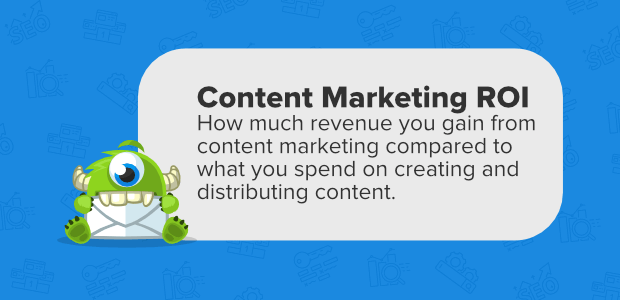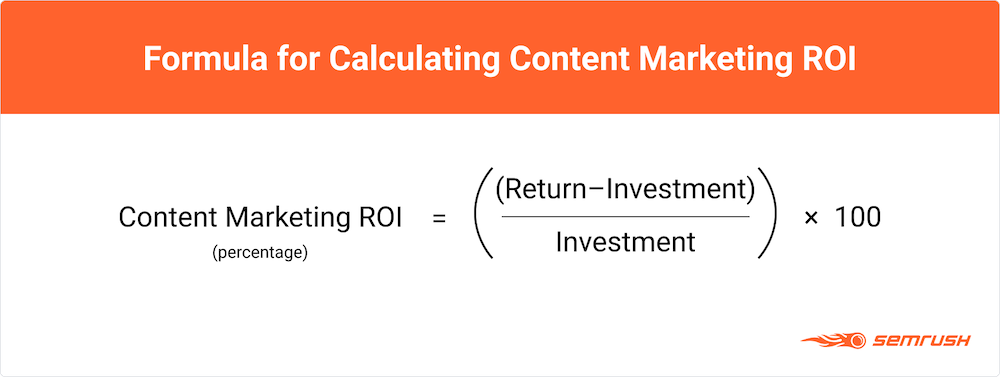
Content marketing is a big part of developing brand awareness and loyalty. It’s incredibly effective but it also takes time and money, which means it’s important to get the best return on your investment possible.
The return on investment (ROI) for content marketing is essentially how much revenue you generate from a piece of content vs. how much it cost to create it. While content success is frequently linked to revenue goals, the ROI of content marketing and content success is not the same thing. Nowadays we can see the evolution of content marketing as well.
Steps To Maximize Your ROI

The thing is, every piece of content you generate will not earn you money directly. Some content is developed to nurture leads who are still in the marketing funnel and aren’t ready to purchase. This form of material will not generate direct income, but it will assist get the lead closer to making a purchase. As a result, it has a hand in generating money, but it can be very difficult to track.
Content marketing ROI should not be your sole metric, but it is important to consider when attempting to gain a comprehensive picture of how your content is functioning and how it ties to the ultimate objective of generating revenue.
Maximizing ROI with Content – Top Ways

When marketers plan their content strategy, they consider the long term. It takes time for content marketing, and especially SEO, to work its magic. If you create high-quality material as part of your content marketing initiatives, you should see your ROI grow over time as more people are exposed to your material.
There are a few different ways to maximize your ROI with content:
Identify a Few Channels
Different audiences on different channels and platforms within those channels have a tendency to behave differently. Content that is really popular on one channel may not necessarily perform well on another. You should, ideally, identify which channels work best for the content you’re delivering and where your audience is consuming information before you start creating your content. Then you can tweak everything for those individual audiences, including the topic, viewpoint, and title. Be careful not to spread yourself too thin by trying to be everywhere, especially if you’re new to content marketing.
Keep Updating Your Content
Fresh content, delivered consistently is essential to engage and retain your audience. It’s also important to ensure that anything you’ve produced in the past is up-to-date as the market changes. When you make updates, make sure your audience knows about it by sending a brief tweet or email to individuals who have previously loved the content. You’ll get more shares and links as a result of this. Visitors will have no issue sharing your material long after it was initially published if you maintain updating it on a regular basis–and it will remain relevant to new audience members.
Keep Promoting the Content
The majority of your ROI will come from content promotion. While quality content is a fantastic start, it won’t get you anywhere without letting people know that the content is there, ready for them to consume. Some elite marketers, such as Derek Halpern, spend as much as 80% of their time promoting content and only 20% on developing it. You’ll probably need to spend more time promoting and advertising your previous material if you want to optimize your ROI.
Make Better Content than Your Competitors
Your content should outperform all of the content of your rivals. The higher the quality of your material, the more it sticks out from the crowd. Readers judge your content’s quality in part by comparing it to that of others. There won’t be a substantial change in your return if there isn’t a major variation in perception. So do your research and take your time and, if necessary, hire help to develop the best content possible. Alternatively, you might just improve your content as others catch up, hoping that no one else comes out with a guide like this that you can’t match.
Promote Through Outbound and Inbound Marketing
You’re missing out on a lot of reaches if you simply rely on organic traffic on most social platforms. However, many marketers, particularly newer ones, despise advertising because of the cost and the fact that it can be confusing to get started. If you typically use inbound marketing, you may be averse to outbound marketing, but a combination of the two can give you great results; they don’t have to be mutually exclusive. You may utilize both of them to promote a piece of content at the same time. And when you find the correct mix, your return on investment may skyrocket.
Optimize Your Sales Funnel

A sales funnel is what will funnel your new followers into engaging with your content and, eventually, buying from you. It’s critical that you have a sales funnel in place, with a product (or another monetization mechanism) for visitors and subscribers to purchase at the end. Make sure there’s a clear path for people to take so they know what you offer and how they can buy it. Doubling your conversion rate at any stage at the bottom of your sales funnel is a simple method to double your content’s ROI.
Measure Your ROI
You must first learn how to calculate your ROI and then track it for each piece or type of content you create. There’s no way to test alternative content production and promotion tactics to discover which ones genuinely boost your ROI unless you quantify it. Content marketing techniques should be refined and improved on a regular basis by good marketers.
Generate Better ROI With Content

When it comes to selling, appealing to the public, and generating a return on investment, content is critical. One cannot expect a website or even a business to succeed without accurate, high-quality content that attracts and engages potential buyers. This is why content is so important in digital marketing initiatives.
These content ideas will improve your ROI:
- Create Content Through Variety
The majority of marketing initiatives are centered on written content ideas such as blog posts, articles, and copywriting, which has the benefit of generating greater market returns. But people are also increasingly turning into audio and video content. Know what your audience prefers and then deliver it to them, consistently.
- SEO and Social Media
Content must be focused on specific keywords in order to produce a large number of leads and make an impact on customers. This makes the content more searchable, so audience members can find exactly what they need. Using search engine optimization is most important on your own website when posting blogs, video summaries, or podcast show notes. But keywords and engaging content are also important on social media. - Writing White Papers
White papers have a higher level of trust among the target audience; thus, marketing strategists should make effective use of them to get a strong return on investment. Creating content like this necessitates skilled analysis and a thorough understanding of the product or service in question. Like other content, white papers will provide the best ROI when they are carefully researched and well-written. - Writing Case Studies, Testimonials, and Surveys
Case studies, testimonials, and survey results offer social proof that your offer is high quality. Because consumers connect and react more on these platforms, social media sites are critical for promoting this sort of content. Talk to your customers, ask for their input, then publish it–on your website and on social media. Video is extremely valuable when producing testimonial posts, but written content works well here too, and infographics serve case studies and survey content well.
How Do You Calculate ROI In Content Marketing?

Content marketing now accounts for a significant portion of most organizations’ marketing budgets, so it’s important to determine whether your actions are working. In fact, marketers set aside 27% of their marketing spending for content creation and dissemination.
There are four steps to calculate ROI in content marketing:
Step 1: Figure out how much money (and time converted to dollars) you spend on content creation. Don’t forget to factor in the cost of work done by other departments, as well as other content creation costs like photographs, videos, and infographics.
Step 2: Calculate the amount of money spent on content distribution and publication. You can figure out the campaign’s entire cost by adding the costs of content production, delivery, and publication. When determining your content marketing ROI, this will be your investment.
Step 3: The total revenue earned in return for expenditure must be calculated. This may not be a neat and tidy calculation, especially if you’re relying on organic (free) content and not advertising, but it is possible to get close. Look at a specific campaign or content series and then determine the number of sales made during the promotional time. Content and sales might have a direct or indirect relationship.
Step 4: Finally, you must calculate the return on investment. Follow this easy formula to compute the content marketing ROI from direct sales:
ROI Percentage = (Revenue-Investment)/Investment X 100
This, however, is merely the observable aspect of ROI. The direct ROI isn’t the sole factor in content marketing success. Many other factors come into play, such as lead quality, website traffic, social media, exposure, engagement, and SEO returns.
If you don’t want to become overwhelmed, don’t track too many metrics for a single project, and don’t try to track metrics for a single piece of content. Setting clear goals and selecting a few measurements that are related to that aim is preferable.
How Do You Guarantee An ROI With Content?
Experienced marketers understand the importance of having a strategy in place before beginning any campaign. However, just 37% of companies have a written content marketing plan.
You must evaluate your existing situation, including website traffic, page views, social shares, click-through rates, conversion rates, and so on, and set objectives to achieve. Also, make sure your key KPIs are in line with your overall marketing objectives and keep track of them over time. You’ll only know how you’re doing if you keep track of your progress. It’s critical to review your content marketing strategy on a frequent basis to verify that it’s still effective.
Want to get better results? Consider your audience’s point of view while creating material, and it will resonate with them more. To get and keep their attention, back it up with strong research and relevant examples. When done correctly and properly, the combination of SEO with content may provide outstanding results. Amplify your content properly and invest in an app that will help you harness the power of social proof and gain the business of the 77% of people who suggest businesses to their friends and family.
